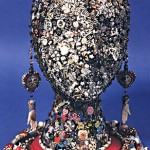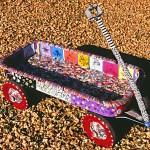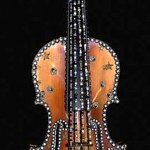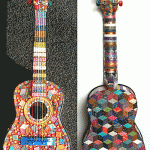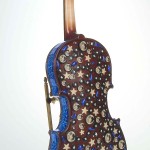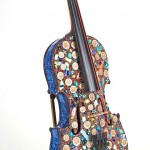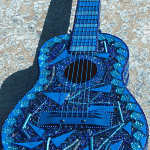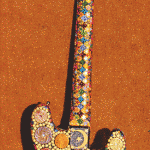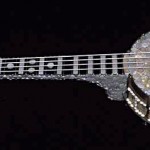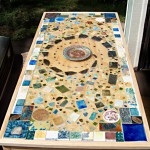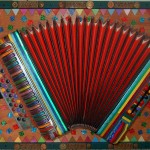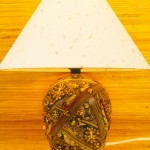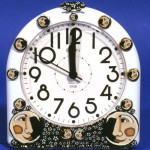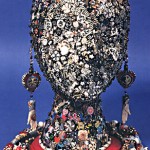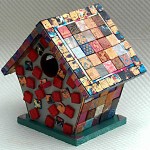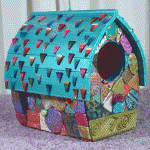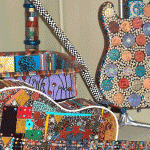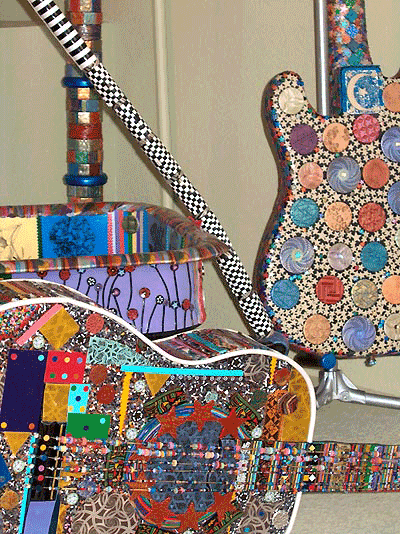 During the course of production manufacturing with my wife at Sarajane’s Polyclay Gallery, many colors of acrylic clays are custom blended, hundreds of millefiore canes are produced, and sheets of patterned and impressed textures are created. As a part of this flow, extra components are generated at the same time–the difference between slicing and baking 5 pieces and 50 is not that great. The nature of having all these extra bits and pieces is cumulative. They pile up in bins and baskets until such time as they are made into something else. This could be a button,an embellishment for a scrapbook page, a pin, charm, or a bead. Many are selected for use in mosaic sculptural pieces.
During the course of production manufacturing with my wife at Sarajane’s Polyclay Gallery, many colors of acrylic clays are custom blended, hundreds of millefiore canes are produced, and sheets of patterned and impressed textures are created. As a part of this flow, extra components are generated at the same time–the difference between slicing and baking 5 pieces and 50 is not that great. The nature of having all these extra bits and pieces is cumulative. They pile up in bins and baskets until such time as they are made into something else. This could be a button,an embellishment for a scrapbook page, a pin, charm, or a bead. Many are selected for use in mosaic sculptural pieces.
In that the first generation of artistic pursuit is musical for me, I end up in the possession of instruments given to me by others, which require fixing or transforming. While I’m more able than most to love a microtonal composition, an instrument that can no longer hold its tuning or is structurally unsafe is destined to become sculpture.
One of the most curious things about these sculptures is that although strings are obviously heavily beaded or replaced with colorful telephone wires and the sound holes are completely covered, the first thing some people do upon seeing these works close up is to strum the strings. Many then follow this up by asking “Do you still play it?” The answer is no: they were unplayable prior to being beautified…and this process doesn’t make them any more musically-able.
Instruments offer a challenging number areas with both flat and curved planes. Surface types include metal, wood, plastic and even stretched animal hides. So far the embellished instruments include two violins,an acoustic guitar and an electric bass guitar, an antique tenor banjo, an accordion and two smaller guitars. Other pieces include lamps, a Radio Flyer Wagon, shadowboxes with masks,a head full of beaded pins, and clocks and birdhouses.
Other big projects include tables and custom furniture. Enviro-Tex two part epoxy resin and polymer clay are compatible for use in poured table tops, and compliment each other in the techno-tribal style we have developed here.
Rust-Oleum Varathane is also primarily used as sealant and UV protectant on the surface of polymer tesserae pieces used in making mosaics, and it is sometimes used as an adhesive to affix many bits in place, along with adhesives such as PVA glues and cyanoacrylates. The spray Varathane is a valuable protectant, and easy to apply to areas where brushwork is sure to be a problem. After more than 5 years there is no deterioration of the surface of the Premo polymer clay used, so compatibility of these products seems to be good.
In addition to caned, molded,stamped, transfered, extruded and otherwise decorated polymer clay, mosaics can include many special materials collected over decades. Antique glass tiles, modern fused and dichroic glass, metallic foils and metals, glitters, beads, buttons, plastic coated and colored wires,paper graphics and more offer an unlimited source of decorative materials.

